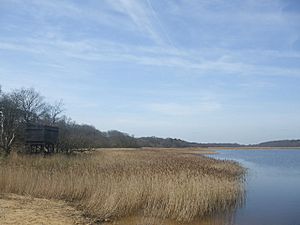Benacre National Nature Reserve facts for kids
The Benacre National Nature Reserve is a very special protected area in Suffolk, England. It's located right on the North Sea coast. This amazing reserve is found between the towns of Lowestoft and Southwold. It covers about 393 hectares (that's like 971 football fields!).
Contents
What is Benacre National Nature Reserve?
Benacre NNR is a place where nature is protected and studied. It's made up of different natural areas. You'll find open water lagoons and large areas of reeds. These include Benacre Broad, Covehithe Broad, and Easton Broad. The reserve stretches south towards Reydon.
Habitats at Benacre
The reserve has many different types of homes for plants and animals. There are huge reedbeds, which are like tall grassy wetlands. You can also find woodlands and areas of heathland. Some parts of the reserve are old pits. These pits were created when gravel was dug out of the ground.
Amazing Animals and Plants
Benacre is a fantastic place for wildlife. Over 100 different kinds of birds breed here! Some of the special birds you might see include the marsh harrier. You might also spot the bearded reedling and the water rail. Sometimes, you can even see a bittern, which is a very shy bird.
Special Plants
The reserve is also home to unique plants. You can find seakale growing here. There's also sea holly and yellow-horned poppy. These plants are special because they can live close to the sea.
Reed Farming
The reeds in the reserve are very important. They are grown and harvested for the thatching industry. Thatching is an old way of making roofs from dried plants. This also helps the bearded reedling find a good home in the reeds.
Protecting Our Coastline
The coastline at Benacre is changing very quickly. The sea is slowly washing away the land. This is called coastal erosion. The reserve is also threatened by sea level rise. This means the sea is getting higher over time.
What is Being Done?
People at the reserve are working hard to protect it. They are digging new lagoons to help stop the sea from coming in. They are also building more sea defences. These defences help protect the land from waves. They are also planting new trees. This replaces the woodland that has been lost to the sea.


